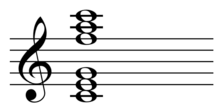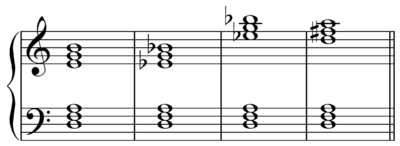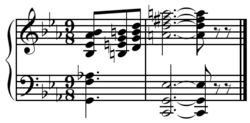Polychord

In music and music theory, a bichord or polychord consists of two or more chords, one on top of the other.[2][3][4] In shorthand they are written with the top chord above a line and the bottom chord below,[5] for example F above C: .
The use of polychords may suggest bitonality or polytonality. Harmonic parallelism may suggest bichords.
Examples may be found in Igor Stravinsky's Petrushka, p. 15, and Rite of Spring, "Dance of the Adolescents" (1921) [6] (see Petrushka chord). They may also be found in the song "Point of No Return" from Andrew Lloyd Webber's The Phantom of the Opera, including chords such as E♭m over Fm.[7]

In the polychords in the image above, the 1st, "might well suggest," a thirteenth chord, the 2nd may suggest a, "d minor ninth chord with upper extensions," but the octave separation of the 3rd makes the suggestion of, "two independent triads with their a m9 apart," even more likely, and the 4th is a, "split-third chord."[8]
Extended chords contain more than one triad, and so can be regarded as a type of polychord:
_vs_Db_over_G_chord.png)
For example G7(♯11♭9) (G-B-D-F-A♭-C♯) is formed from G major (G-B-D) and D♭ major (D♭-F-A♭), or .[5] (C♯=D♭)
The Lydian augmented scale, "has a polychord sound built in,"[10] created by superimposing the Caug and the Emaj (![]() Play ) and/or F♯dim (
Play ) and/or F♯dim (![]() Play ) triads that exist in the scale, this being, "a very common practice for most bop and post-bop players [such as McCoy Tyner]."[11]
Play ) triads that exist in the scale, this being, "a very common practice for most bop and post-bop players [such as McCoy Tyner]."[11]
Examples of extended chords include the Elektra chord.

When one or both of the chords in a polychord are not "chords" in some exclusive sense according to some preferred chord theory or other, polychords devolves into chordioid technique.
See also
Sources
- ↑ Pen, Ronald (1992). Introduction to Music, p.242. ISBN 0-07-038068-6.
- ↑ Haerle, Dan (1982). The Jazz Language: A Theory Text for Jazz Composition and Improvisation, p.30. ISBN 978-0-7604-0014-2. "The term polychord literally means many (poly) chords. In actual practice, a polychord is usually a combination of only two chords which creates a more complex sound."
- ↑ Guy Capuzzo, Tom Dempsey (2006). Theory for the Contemporary Guitarist, p.76. ISBN 978-0-7390-3838-3. "A bichord (other-wise known as a polychord) consists of two triads played together."
- ↑ Edward Shanaphy, Joseph Knowlton (1990). The Do It Yourself Handbook for Keyboard Playing, p.62. ISBN 978-0-943748-00-9. "A polychord is nothing more than the playing of two chords at the same time."
- 1 2 Policastro, Michael A. (1999). Understanding How to Build Guitar Chords and Arpeggios, p.168. ISBN 978-0-7866-4443-8.
- ↑ Reisberg, Horace (1975). "The Vertical Dimension in Twentieth Century Music", Aspects of Twentieth-Century Music, p.336. Wittlich, Gary (ed.). Englewood Cliffs, New Jersey: Prentice-Hall. ISBN 0-13-049346-5.
- ↑ "Past the Point of No Return". Scribd. Retrieved Jul 6, 2009.
- 1 2 Kostka & Payne (1995). Tonal Harmony, p.494. Third Edition. ISBN 0-07-035874-5.
- ↑ Marquis, G. Welton (1964). Twentieth Century Music Idioms. Englewood Cliffs, New Jersey: Prentice-Hall, Inc.
- ↑ Munro, Doug (2002). Jazz Guitar: Bebop and Beyond, p.36. ISBN 978-0-7579-8281-1.
- ↑ Munro (2002), p.38.
- ↑ Walter Everett (Autumn, 2004). "A Royal Scam: The Abstruse and Ironic Bop-Rock Harmony of Steely Dan", p.208-209, Music Theory Spectrum, Vol. 26, No. 2, pp. 201-235.